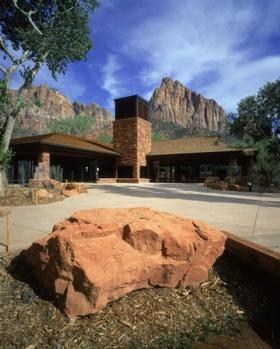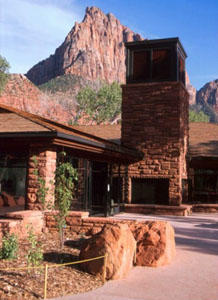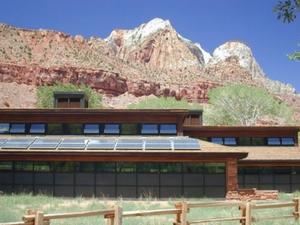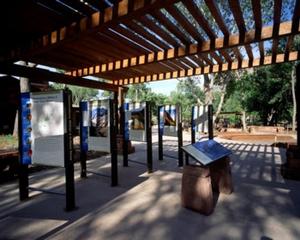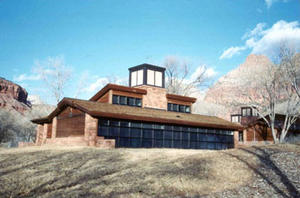Zion Visitor Center
Project Overview
As a primary component of the Zion Canyon Transportation System, this low-energy, sustainable facility is the entry to a transit- and pedestrian-centered visitor experience, providing park information, interpretation and trip-planning assistance within a resource environment. The new visitor center is part of a transportation system that seeks to reduce resource impacts and enhance the visitor experience. Consisting of indoor and outdoor spaces for visitor services, this facility creates a setting to promote and interpret park resources and agency conservation values. In creating the Zion National Park Visitor Center, the National Park Service (NPS), working with DOE's National Renewable Energy Lab (NREL), has complemented Zion's natural beauty.
Regional/Community Design
The site is within walking distance of two shuttle bus routes and commercial amenities. Bicycle and pedestrian transportation are encouraged through bike racks and shower/changing facilities.
Green Strategies
Responsible Planning
-Ensure that development fits within a responsible local and regional planning framework
Support for Appropriate Transportation
-Provide showers and changing areas for bicycle and pedestrian commuters
-Provide storage area for bicycles
Property Selection Opportunities
-Select already-developed sites for new development
Land Use & Site Ecology
Using this site, previously a campground, avoided unnecessary impact of natural and cultural resources. No undeveloped lands were used. Underutilized, existing areas in Springdale were used for parking and facility development. Construction was phased to minimize disturbance. Topsoil was stockpiled, runoff was diverted to existing sediment-catching areas, existing vegetation was maintained, no soil was transported off site, and dust control was implemented in roadwork adjacent to the existing campground.
Development Impacts
-Minimize development impact area
-Limit parking area
Ecosystem Restoration
-Replant damaged sites with native vegetation
Landscape Plantings
-Plant trees to shade parked vehicles
Construction Impacts
-Designate appropriate staging areas for construction-related activities
Demand for Irrigation
-Select plants for drought tolerance
Integration with Site Resources
-Use light-colored pavement to reduce heat island effect
Low-Impact Siting
-Select an already-developed portion of a site for new development
Bioclimatic Design
Several effective energy features were included in this project: daylighting, Trombe walls for passive solar heating, downdraft cooltowers for natural ventilation cooling, energy-efficient lighting, and advanced building controls. A roof-mounted photovoltaic (PV) system provides electric power. This project will save roughly $14,000 and about 10 kW of electric demand per year through these energy-saving measures.
Light & Air
Cool towers (which provide over 5 air changes per hour) and operable windows provide natural ventilation to building occupants. Thermal, ventilation, and lighting systems may be controlled by users. Extensive daylighting was implemented. The building remained unoccupied for 2 weeks following construction, while commissioning and final punch items were completed.
Green Strategies
Visual Comfort and The Building Envelope
-Use skylights and/or clerestories for daylighting
Visual Comfort and Interior Design
-Design open floor plans to allow exterior daylight to penetrate to the interior
Ventilation and Filtration Systems
-Provide occupants with access to operable windows
Ventilation During Construction
-Purge the building of VOCs during furniture installation prior to move-in
Building Commissioning for IEQ
-Use a comprehensive commissioning process to ensure that design intent is realized
Facility Policies for IEQ
-Recommend a non-smoking policy for the building
Water Cycle
Native low-water-use grasses and shrubs were used for landscaping. Historic irrigation channels were restored. Collected rainwater joins river water and is diverted through a series of gravity-fed irrigation ditches. High-efficiency irrigation techniques and drip irrigation with a weather data controller were installed primarily to encourage the reestablishment of native vegetation. (It may be possible to achieve 100% reduction of potable water for landscaping after plant establishment.)
Irrigation Systems
-Use appropriate grading to retain irrigation and reduce runoff
-Use water-efficient irrigation fixtures
Energy Flows & Energy Future
A 70% reduction in energy use was met through the design and implementation of natural ventilation, efficient lighting, effective glazing, insulation, passive downdraft cooltowers, Trombe walls, photovoltaics, energy-efficient landscaping, and an energy management system.
The roof insulation is Structural Insulated Panels (SIP's). The walls are 6-inch steel studs with a spray-in-place foam insulation.
The cooltower design was adapted from a technique used to condition outdoor patio spaces. Hot dry air is drawn into evaporative cooling pads at the top of the tower. The air is now more dense and falls naturally through the tower into the space. High windows in the building relieve the hot air.
12% of the total energy load is provided by on-site PV, with an additional 10% allowed-for in the building design.
Metrics
Materials & Construction
20% of materials, including stone, concrete, and paving, were manufactured within 500 miles (800 km) of the site.
Diversion of Construction & Demolition Waste
-Cleared vegetation and pavement were recycled.
Green Strategies
Design for Materials Use Reduction
-Reconsider whether all space demands in building program are needed
Recycling by Occupants
-Specify recycling receptacles that are accessible to the occupants
Transportation of Materials
-Prefer materials that are sourced and manufactured within the local area
Other Information
Financing Mechanisms
Equity: Government appropriation
The Zion Visitor Center cost 30% less to build than a comparable National Park Visitor Center.
The project was federally funded and competitively procured.
Energy-saving measures will save roughly $14,000 per year and will result in about 10 kW of electric demand savings.
Designing the electrical system and installing the conduit for future PV was ideal. When PV was added, it was installed in a few hours. The photovoltaic system and inverter are used for an uninterruptible power supply (UPS) system. A better definition of what loads were to be UPS-powered would have been useful. The UPS system is not guaranteed to provide continuous power. About 5% of the outgates have left the building with a brief (less than 1 second) outage—enough to reset computers. Some small UPS computer backups have been installed for the brief outages.
Cooltowers have worked as well as direct evaporative coolers except in the enclosed offices, where additional small fans were added. The recommendation is that cooltowers be used only in large open spaces.
Daylighting levels have been lower than anticipated. This was due to the large number of dark beams in the space and the white stained ceilings (instead of white paint, as modeled). In addition, bug screens on the operable windows have affected the daylighting level. The result has been additional operation of artificial lighting.
Trombe walls have exceeded operational expectations. However, a design change resulted in two enclosed offices against Trombe walls, and these offices tend to overheat. In large open zones, the Trombe walls are very effective.
Additional Images
Project Team and Contact Information
| Role on Team | First Name | Last Name | Company | Location |
|---|---|---|---|---|
| Project Leader (also Landscape Architect) | Patrick | Shea | National Park Service--Denver Service Center | Denver, CO |
| Architect | Larry | Kilborn | National Park Service--Denver Service Center | Denver, CO |
| Architect | Krista | Copeland | National Park Service--Denver Service Center | Denver, CO |
| Energy consultant (Researcher) | Ron | Judkoff | National Renewable Energy Laboratory | |
| Energy consultant, Senior engineer | Paul | Torcellini | National Renewable Energy Laboratory | Golden, CO |
| Landscape architect | Victoria | Stinson | National Park Service--Denver Service Center | Denver, CO |
| Landscape architect | Steve | Burns | National Park Service--Denver Service Center | Denver, CO |






